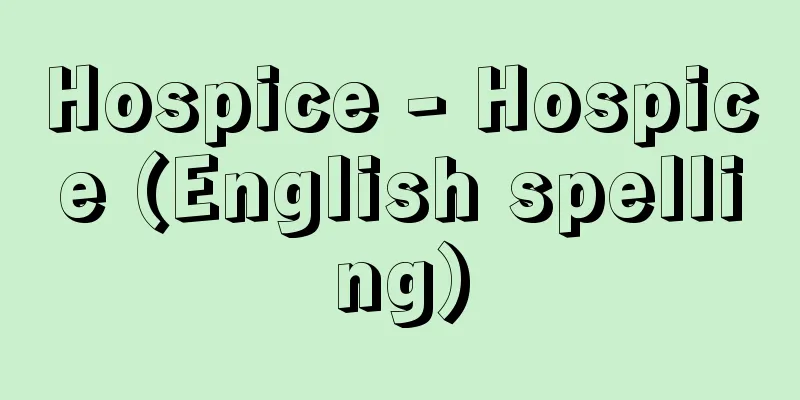Hospice - Hospice (English spelling)

|
A place that provides support and care to patients with incurable diseases, such as terminal cancer, and their families, to help them live comfortable lives. Traditionally, hospice was a word that expressed a philosophy, and at the same time, it also represented a place where that philosophy was put into practice. In other words, it meant "the philosophy of providing support and care to patients in the terminal stage of an incurable disease (mainly terminal cancer in Japan) and their families, by a team made up of various experts and volunteers working together, so that they can live as humane and comfortable a life as possible," and at the same time, it meant "the place where that support and care is provided." Care provided under this philosophy was called hospice care. Depending on where the care is provided, it is divided into institutional hospices and home hospices, but the basic philosophy and the nature of the care are the same. However, as a result of hospices providing specialized care to terminally ill cancer patients, the general public has often simply understood hospices as places to die, contrary to the reality that the goal there is to live life to the fullest. Also, as will be discussed later, in Japan since 1990 (Heisei 2), hospices that meet the establishment standards of the Ministry of Health and Welfare (now the Ministry of Health, Labour and Welfare) have been able to provide care as "palliative care wards" under the medical insurance system, primarily to patients with terminal cancer and AIDS. Due to the circumstances described above, in recent years hospice has often been referred to as "palliative care ward" and hospice care as "palliative care." Furthermore, the concept of "palliative care" has evolved from a type of care provided "in the terminal stages of incurable illness" to "an approach to improving the quality of life (QOL) of patients and their families facing problems due to life-threatening illness by providing thorough assessments of pain, physical problems, psychosocial problems, and spiritual problems from an early stage of the illness, and by taking measures to prevent or address these problems so that they do not become obstacles" (WHO, 2002). Palliative care is now considered necessary not only in the terminal stages of an illness, but also from the early stages. [Akio Yamazaki] historyThe history of hospices dates back to medieval Europe. At the time, monasteries across Europe offered lodging and food to pilgrims who became tired or fell ill on their way to the Holy Land of Jerusalem. The activities of these monasteries are said to be the origins of modern hospices. Hospice activities spread in France, Germany, Ireland and other countries from the 17th century onwards, but the history of modern hospices, which focus on the care of terminally ill cancer patients, began with St. Christopher's Hospice, founded by Cicely Saunders (1918-2005) in London, England in 1967. Modern hospices then spread rapidly in the United States, with the first being the Connecticut Hospice, founded in 1974. Such hospice efforts are also known as the hospice movement, and have spread all over the world, including Asian countries such as Singapore, Taiwan and South Korea. The first hospice in Japan was opened in 1981 at Seirei Mikatahara Hospital in Hamamatsu, Shizuoka Prefecture. Progress was slow after that, but from 1990, hospital wards that met certain facility standards set out by the Ministry of Health and Welfare (now the Ministry of Health, Labour and Welfare) were certified as palliative care wards, and when palliative care was provided there, mainly to terminal cancer patients, a fixed amount of medical fees could be claimed (25,000 yen per day in 1990, 38,000 yen in 2000, and 37,800 yen as of 2008). As a result, hospices, which had previously struggled financially, were able to operate to a certain extent by receiving certification as a palliative care ward. Backed by such medical expenses, the number of hospices (palliative care units) has rapidly increased since the late 1990s, and from five hospices nationwide in 1990, the number has grown to 183 as of June 2008. These numbers are continuing to increase. [Akio Yamazaki] The role of hospice palliative care unitsTraditionally, the purpose of hospice palliative care was to support patients and their families in the terminal stages of an incurable disease so that they could live as humane and comfortable a life as possible. However, hospice palliative care has come to be recognized as a form of care that is necessary not only during the terminal stage of an illness, but also from an early stage onwards. The Japan Hospice Palliative Care Association, a non-profit organization, has set out the following seven basic policies for this purpose. (1) Relieving pain and other distressing symptoms. (2) Respect life and recognize death as natural. (3) Do not attempt to unreasonably prolong life or intentionally cause death. (4) Support patients so that they can live their lives as individuals until the end. (5) Support families in dealing with various difficulties, from the time the patient is recovering to after the patient's death. (6) It should be applied from the early stage of the illness and also address the suffering that arises with aggressive treatment. (7) Improve the quality of life of patients and their families and have a positive impact on their medical condition. The form of care provided to implement the above seven items is as follows: [Akio Yamazaki] Current issues and future challenges facing hospice palliative care units in JapanAs of June 2008, there are 183 hospice palliative care units (total beds: about 3,580) that are trying to provide hospice palliative care in Japan. Even if these facilities are operated effectively, it is estimated that the number of patients who can receive hospice palliative care in a year is about 20,000. On the other hand, the number of cancer deaths in Japan per year reached about 330,000 as of 2008. This shows that only about 6% of cancer deaths can receive care in a hospice palliative care unit, even if they wish. In addition, the average length of stay in these hospice palliative care units nationwide is about six weeks, which is six times the average length of stay in Western hospices, which mainly provide hospice palliative care at home, about one week. If home hospice palliative care is improved in Japan in the future and the average length of stay in hospice palliative care units can be shortened, more patients will be able to use hospice palliative care units. This is why there is a need to improve home care. However, despite the small number of facilities, many hospice palliative care wards across the country have an average annual bed occupancy rate that does not reach 80%. One of the reasons for this is that patients are not fully informed of their illness and condition, so they do not have the option of receiving hospice palliative care. Whether more terminally ill patients can receive hospice palliative care will depend on whether true informed consent (sufficient explanation from the doctor and consent from the patient) is established in Japan. Another current problem is the small number of doctors who are willing to work in hospice palliative care. Although there are various things that doctors should do for terminally ill patients, the importance of hospice palliative care has hardly been recognized in medical education. Another future issue is the improvement of the curriculum on hospice palliative care in medical education. Furthermore, the presence of volunteers is extremely important in hospice palliative care. For example, what patients and their families who are facing death want to cherish is often not something special, but rather everyday life itself. And because these types of daily life support services that can be provided by non-professionals are areas where volunteers can demonstrate great capabilities. Introducing volunteers to hospice palliative care is also a challenge that Japanese hospice palliative care wards must tackle in the future. Another challenge is to make hospice palliative care, which is a fairly universal form of care, available to people other than cancer patients. [Akio Yamazaki] "My 1200 Days in Hospice" by Yamazaki Akio (1995, Kairyusha)" ▽ "Hospice Handbook for Making Life Shine to the End" by Yamazaki Akio, Sakuramachi Hospital St. John Hospice, and St. John Hospice Care Institute (2000, Kodansha)" ▽ "Hospice Manifesto - Living in Hospice" by Yamazaki Akio and Yonezawa Satoshi (2000, Shunjusha)" ▽ "The Latest Hospice Q&A 100" by Tani Sokichi and Nishikori Hajime (1999, Tokyo Shoseki)" ▽ "Systematic Nursing Course Volume 1: Terminal Care" Revised 3rd Edition by Kashiwagi Tetsuo (2000, Igakushoin)" ▽ "Healing Terminal Care" by Kashiwagi Tetsuo (2002, Saishin Igakusha)" ▽ "The Definitive Edition of Hospice and Palliative Care" by Kashiwagi Tetsuo (2006, Seikaisha)" ▽ "Hospice - Its Philosophy and Movement," edited by Cicely Saunders et al. and supervised translation by Okamura Akihiko (2006, Kirara Shobo)" ▽ "The New Hospice Manifesto - On Spiritual Care," by Yamazaki Akio and Yonezawa Satoshi (2006, Kirara Shobo)" ▽ "Hospice Palliative Care What Patients Want Today - What is Needed in Hospice Palliative Care in Hospitals and at Home," by Nozawa Kazuma (2006, Paru Publishing)" ▽ "I Wanted to Talk to You More - The Father of Hospice in Japan and 20 Years of Practice," by Kashiwagi Tetsuo (Nikkei Business Library) [References] | | | | |Source: Shogakukan Encyclopedia Nipponica About Encyclopedia Nipponica Information | Legend |
|
末期の癌(がん)など治癒の困難な疾患にかかった患者とその家族に対して、快適な生活を送れるように支援およびケアを提供する場。 従来、ホスピスとは理念を表すことばであり、同時にその理念を実践する場をも表していた。すなわち、「さまざまな専門家やボランティアが協力してつくったチームによって、治癒の困難な疾患の終末期(日本ではおもに末期癌)にある患者および家族が可能なかぎり人間らしく快適な生活を送れるように支援とケアを提供するという理念」であり、「同時にその支援やケアを提供する場」をも意味していた。この理念のもとに行われるケアがホスピスケアといわれていた。ケアが提供される場所によって施設ホスピスと在宅ホスピスに分けられていたが、基本的理念もケアもそのあり方は同じものである。 しかしながら、ホスピスが末期癌患者に対して専門的なケアを提供してきた結果、そこでは命の限りを精一杯生きるという内実とは裏腹に、一般の人々からはホスピスはまさに、死に場所と短絡的に理解されることも多くなった。 また、日本では後述もするが、1990年(平成2)より厚生省(現厚生労働省)の設置基準を満たしたホスピスは「緩和ケア病棟」として、末期の癌と末期のエイズ患者を主なる対象に医療保険制度に基づいてケアを提供できるようになった。 前記のような事情の下、近年では、ホスピスは「緩和ケア病棟」に、ホスピスケアは「緩和ケア」に言いかえられて表現されることが多くなった。 さらには「緩和ケア」の概念が、「治癒の不可能な疾患の終末期」に提供されるケアのあり方から、「生命を脅かす疾患による問題に直面している患者とその家族に対して、疾患の早期より、痛み、身体的問題、心理社会的問題、スピリチュアルな問題に関して、きちんとした評価を行い、それが障害とならないように予防したり、対処することで、クオリティ・オブ・ライフquality of life=QOL(生活の質)を改善するためのアプローチである」(WHO=世界保健機関、2002年)とされ、疾患の終末期だけでなく、その早期から必要なケアであると考えられるようになってきている。 [山崎章郎] 歴史ホスピスの歴史は中世ヨーロッパにさかのぼる。当時、ヨーロッパ各地にあった修道院は、聖地エルサレムに向かう巡礼者たちが旅の途中で疲れたり、病気に倒れたとき、一夜の宿と食事を提供したという。この修道院の活動が近代ホスピスの源泉といわれている。 17世紀以降、フランス、ドイツ、アイルランドなどでホスピス活動が広がっていったが、癌の末期患者に対するケアを中心にした現代ホスピスの歴史は、1967年、イギリスのロンドンでシシリー・ソンダースCicely Saunders(1918―2005)が創設したセント・クリストファーズ・ホスピスから始まる。その後、現代ホスピスはアメリカで急速に広がるが、その第1号は1974年に設立されたコネティカット・ホスピスであった。このようなホスピスへの取組みはホスピス運動ともいわれ、シンガポール、台湾、韓国などのアジアの国々も含め世界中に広がっている。 日本におけるホスピスの第1号は、1981年(昭和56)静岡県浜松市にある聖隷三方原(せいれいみかたがはら)病院に開設された。その後の進展は遅々としていたが、1990年(平成2)より厚生省(現厚生労働省)が示した一定の施設基準を満たした病棟は緩和ケア病棟として認定され、そこでおもに末期癌患者に緩和ケアを提供した場合には、定額の医療費(1990年時点では1日2万5000円、2000年3万8000円、2008年時点では3万7800円)が請求できるようになった。そのために、それまで経営的には苦戦を強いられてきたホスピスは、緩和ケア病棟の認可を受けることによって一定の運営が可能となった。このような医療費の裏付けのもと、1990年代後半よりホスピス(緩和ケア病棟)は急増し、1990年には全国で5か所だったホスピスも、2008年6月の時点で183か所を数えるようになった。これらはさらに増加しつつある。 [山崎章郎] ホスピス緩和ケア病棟の役割従来は、ホスピス緩和ケアの目的は治癒不可能な疾患の終末期にある患者および家族が、可能なかぎり人間らしく快適な生活を送れるように支援することであったが、ホスピス緩和ケアが疾患の終末期のみならず、早期から必要なケアであると認識されるようになり、そのための基本方針を、NPO法人日本ホスピス緩和ケア協会は次の7項目としている。 (1)痛みやその他の苦痛となる症状を緩和する。 (2)生命を尊重し、死を自然なことと認める。 (3)無理な延命や意図的に死を招くことをしない。 (4)最期まで患者がその人らしく生きてゆけるように支える。 (5)患者が療養しているときから死別した後に至るまで、家族がさまざまな困難に対処できるように支える。 (6)病気の早い段階から適用し、積極的な治療に伴って生ずる苦痛にも対処する。 (7)患者と家族のQOLを高めて、病状に良い影響を与える。 前記7項目を実践するケアの提供形態としては [山崎章郎] 現在の日本のホスピス緩和ケア病棟の問題点と将来への課題日本でホスピス緩和ケアを提供しようとしているホスピス緩和ケア病棟は、2008年(平成20)6月現在183施設(総ベッド数約3580)である。これらの施設が有効に稼動したとしても、1年間にホスピス緩和ケアを受けることのできる患者数は約2万人と推定される。一方で、日本の年間癌死者数は2008年の時点で約33万人に達している。このことは、望んだとしても、癌死者の約6%しかホスピス緩和ケア病棟でのケアを受けられないことを示している。また、それら全国のホスピス緩和ケア病棟の平均在院期間は約6週間であり、これは在宅でのホスピス緩和ケアが中心の欧米ホスピスの平均在院期間約1週間の6倍にあたる。今後、日本でも在宅におけるホスピス緩和ケアが充実し、ホスピス緩和ケア病棟の平均在院期間が短縮できれば、さらに多くの患者がホスピス緩和ケア病棟を利用できることになる。在宅ケアの充実が求められる所以である。しかしながら、施設数が少ないにもかかわらず、全国のホスピス緩和ケア病棟のなかには、年間の平均ベッド稼動率が80%に達していない施設も少なくない。その理由の一つに患者に対する病名や病状の告知が十分にはなされていないために、ホスピス緩和ケアを受けるという選択ができないことがあげられる。より多くの末期患者がホスピス緩和ケアを受けられるかどうかは、日本に本当の意味でのインフォームド・コンセント(医師の十分な説明と患者の同意)が定着するかどうかにかかっているだろう。あるいはまた、ホスピス緩和ケアに携わろうとしている医師が少ないことも現在の問題である。末期患者に対して医師のなすべきことは種々あるのであるが、医学教育のなかではホスピス緩和ケアの重要性はほとんど認識されてこなかったからである。医学教育におけるホスピス緩和ケアに関するカリキュラムの充実も今後の課題であろう。さらには、ホスピス緩和ケアにおいてボランティアの存在はきわめて重要である。たとえば死を目前にした患者・家族が大切にしようとしていることは、特別なことというよりも日々の日常生活そのもののことが多い。そしてそれら専門家ではなくてもできる日常生活の支援は、ボランティアが大きな力を発揮できる場面であるからである。ホスピス緩和ケアへのボランティアの導入もまた今後の日本のホスピス緩和ケア病棟が取り組むべき課題である。またさらなる課題としては、ケアの形態としてはかなり普遍的なケアであるホスピス緩和ケアの提供を、癌患者以外にも提供できるようにしていくことがあげられる。 [山崎章郎] 『山崎章郎著『僕のホスピス1200日』(1995・海竜社)』▽『山崎章郎・桜町病院聖ヨハネホスピス・聖ヨハネホスピスケア研究所著『「生」を最後まで輝かせるホスピス・ハンドブック』(2000・講談社)』▽『山崎章郎・米沢慧著『ホスピス宣言――ホスピスで生きるということ』(2000・春秋社)』▽『谷荘吉・錦織葆著『最新ホスピスQ&A100』(1999・東京書籍)』▽『柏木哲夫著『系統看護学講座別巻1 ターミナルケア』改訂3版(2000・医学書院)』▽『柏木哲夫著『癒しのターミナルケア』(2002・最新医学社)』▽『柏木哲夫著『定本ホスピス・緩和ケア』(2006・青海社)』▽『シシリー・ソンダース他編、岡村昭彦監訳『ホスピス――その理念と運動』(2006・雲母書房)』▽『山崎章郎・米沢慧著『新ホスピス宣言――スピリチュアルケアをめぐって』(2006・雲母書房)』▽『野沢一馬著『いま患者が求めるホスピス緩和ケア――病院、在宅のホスピス緩和ケアではなにが求められているのか』(2006・ぱる出版)』▽『柏木哲夫著『あなたともっと話したかった――日本のホスピス生みの親・20年の実践』(日経ビジネス人文庫)』 [参照項目] | | | | |出典 小学館 日本大百科全書(ニッポニカ)日本大百科全書(ニッポニカ)について 情報 | 凡例 |
<<: Hospitalism - hosupitarisumu (English spelling) hospitalism
>>: Voznesenskii, Andrei Andreevich
Recommend
hypnoanalysis
...Not only is it used to remove symptoms, but it...
Kashubian
…But the written language is based on a dialect t...
Samoa [Islands] - Samoa
A group of islands in the central South Pacific Oc...
Monnet, J.
...However, after the war, this idea was not acce...
Pupa - Iyo
…They are common in lower holometabolous insects ...
Mi'rāj (English spelling) [Arabic]
Originally it meant a ladder. Later it came to be ...
Nicolaus Copernicus
Polish priest and astronomer. Founder of the heli...
Stadium
…The stadium was a rectangle about 200 meters lon...
Up and Under
…In addition, as a special rule in Japan, a sin-b...
Beaverbrook - 1st Baron Beaverbrook
British journalist and politician. His real name ...
Itoga Village
...A city located at the mouth of the Arida River...
robe me-décolletée (English spelling)
…The Western-style uniform system was established...
Nagi [town] - Nagi
A town in Katsuta County in the northeastern part ...
Yan'an Pagoda
...Yen'an is still important as a revolutiona...
Iwanami Culture
…Iwanami Shinsho, which was launched in 1963, was...









